The difference between a good lampshade and a great lampshade for your lamp can be a small one…but your choice can often have a tremendous impact on your decor – the lampshade you chose can make an ordinary lamp – and room extra-ordinary. Many interior decorators will tell you that selecting the right lighting – accent, task and decorative – is the most difficult part of their work; at the same time, they are also quick to point out that it is the lighting selections that will make the difference between success or failure.
Lampshades come in numerous sizes, shapes and styles, colors and proportions. The choice of shade for any given lamp is almost always an individual one – what might look great to one individual, might not look right to another person. While different people have different style preferences, there are some basic guidelines to shade selection.

Lampshade Shapes & Styles
There are two types of lampshades: hardback and silk. Each type comes in a wide variety of shapes, styles, fabrics and colors, and sizes.
Hardback Lampshades
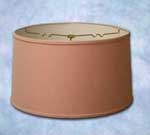 Hardback shades are made by laminating a fabric or paper onto a plastic liner. Each shade has a top ring and a bottom ring, and the laminated fabric is manufactured to attach to each ring, and then glued on one or more sides, forming the seam. The inner plastic liner can be translucent or opaque, while the outer, visible fabric can be any type of woven fabric including linen, silk, satin, muslin, or one of many different types of parchments or paper. Hardback shades are not washable, and over time the plastic liner will yellow with age, distorting the quality of the light produced by the lamp.
Hardback shades are made by laminating a fabric or paper onto a plastic liner. Each shade has a top ring and a bottom ring, and the laminated fabric is manufactured to attach to each ring, and then glued on one or more sides, forming the seam. The inner plastic liner can be translucent or opaque, while the outer, visible fabric can be any type of woven fabric including linen, silk, satin, muslin, or one of many different types of parchments or paper. Hardback shades are not washable, and over time the plastic liner will yellow with age, distorting the quality of the light produced by the lamp.
Silk Shades
 The name “silk shade” is a little bit of a misnomer because these shades are not necessarily made from a silk fabric. Generally the term “silk shade” is used to refer to a shade whose liner is made from a fabric, while the outer fabric can be silk, satin, linen, or a variety of other fabrics. Each of these fabrics may be stretched, shirred or pleated. A silk shade has top and bottom rings that are connected by side wires, or struts. The placement and contour of the struts give the shade its shape and allow the material on the outside to follow the shape of the frame. Because a silk shade is built on a frame, it is possible to achieve a wide variety of shapes including bells, scallops, rounded corners, v-notches and gallery bottoms. Silk shades can be washed by immersing them in warm, soapy water, then washing with a cloth or very soft brush, drying immediately and evenly. While silk shades generally enjoy a fairly long life, in time, the constant heat generated by the bulb will begin to darken the shade and the lining may deteriorate and tear. If you decide to continue to use the shade, remove the lining altogether to avoid the risk of fire. These shades may be re-lined. Because the manufacture of a silk shade is labor intensive, these shades tend to be more expensive than the hardback shades – though generally, they also enjoy a longer life.
The name “silk shade” is a little bit of a misnomer because these shades are not necessarily made from a silk fabric. Generally the term “silk shade” is used to refer to a shade whose liner is made from a fabric, while the outer fabric can be silk, satin, linen, or a variety of other fabrics. Each of these fabrics may be stretched, shirred or pleated. A silk shade has top and bottom rings that are connected by side wires, or struts. The placement and contour of the struts give the shade its shape and allow the material on the outside to follow the shape of the frame. Because a silk shade is built on a frame, it is possible to achieve a wide variety of shapes including bells, scallops, rounded corners, v-notches and gallery bottoms. Silk shades can be washed by immersing them in warm, soapy water, then washing with a cloth or very soft brush, drying immediately and evenly. While silk shades generally enjoy a fairly long life, in time, the constant heat generated by the bulb will begin to darken the shade and the lining may deteriorate and tear. If you decide to continue to use the shade, remove the lining altogether to avoid the risk of fire. These shades may be re-lined. Because the manufacture of a silk shade is labor intensive, these shades tend to be more expensive than the hardback shades – though generally, they also enjoy a longer life.
Lampshade Luminance
A lampshade may be either translucent or opaque. The translucent shade may be either a hardback shade or a silk shade. The translucent shade lets the light through with a gentle diffusion. There are many types of translucency. For example, silk is more translucent than coated papers or parchment. The inner surface of a translucent lampshade should be white or off-white for the best results.
There are two types of opaque lampshades. The fully opaque shade lets no light through the sides, but rather casts it upward and downward in a focal glow. The semi-opaque shade permits a small amount of light to come through its surface while casting the majority of the light through the top and bottom of the lampshade. The fully opaque shade is the better shade to use when the light source is being used for tasks such as reading, writing, sewing or other close work. The outer surface of an opaque lampshade can be any color, while the inner surface can be white, gold or silver.
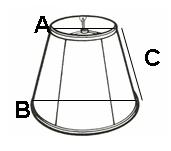
Lampshades are measured and sized using the diameters of the top and bottom as well as a side measurement
Measuring a Lampshade
Lampshades are measured and sized using the diameters of the top and bottom as well as a side measurement:
1. A – the width across the top of the shade
2. B – the width across the bottom of the shade
3. C – the slant height down the side of the shade
4. the distance from the top of the shade to the washer in the center of the top ring (on most shades, this measurement is 3/4”; however, on larger shades the washer is often recessed several inches)
The width across the bottom is what is referred to as the size of the lampshade. The top dimension is only important to the shape of the shade – it does not contribute to how the lampshade will fit the lamp. The side dimension is important in fitting the shade to the lamp. However, with the availability of harps in different heights, shades of varying heights can be adjusted / changed to allow for a proper fit to the lamp.

A fitter is the mechanism by which the lampshade “attaches” to the lamp
Lampshade Fitters
A fitter is the mechanism by which the lampshade “attaches” to the lamp. The four most common types of fitters for a lampshade are the washer, the clip, the Uno, and the Chimney:
The washer fitter is the most common lampshade fitter. It is used with a harp and finial and will work on a variety of lamps including table lamps, floor lamps and swing-arm bridge lamps. The washer is designed to fit on top of a harp. A harp consists of two wires that fit around the lamp socket and nest in a “harp saddle”. The harp saddle is mounted directly below the light socket. Once the harp is in place, the shade is mounted on top of the post, and then held in position by the finial. Some floor lamps are designed with a reflective, white IES bowl. The shade sits on top of the globe, held in place by crimps or notches in the wire to keep it from sliding on the bowl. And, finally, some table lamps (most particularly those designed with twin sockets) have a vertical rod coming up from the middle of the lamp. The washer fitter is designed to fit over the rod, once again held in place by a finial.
The standard bulb clip is designed to snap onto the standard incandescent light bulb (called an Edison Clip). It is used primarily on smaller table lamps – generally those 8″, 9″ and 10″ shades. The candelabra bulb clip (called a Flame Clip) fits chandeliers and wall sconces. The clip-on shade is made in either a full round or half round shape. The latter type is often used on wall bracket lamps and is referred to as a “shield.”
NOTE: Any shade with a washer fitter can be modified to use a clip fitter.
Uno fitters are 1″ rings with inner threads which screw onto the end of a “uno” socket of the floor or table lamp. The uno socket varies from a standard socket only in that it has threads at the end – used to hold the uno shade fitter in place. The uno lampshades are used for bridge lamps in which the bulb hangs downward.
The Chimney fitters are specific to lamps which hold a hurricane – a glass shade used on many oil lamps – both original oil and “electrified” oil lamps.
Lampshade Shapes and Styles
Empire Shades

Empire lampshades slope gradually from the top to the bottom.
Coolie Shades
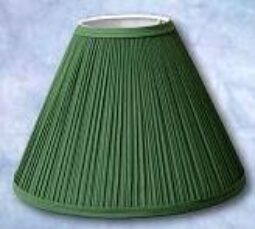
Drum Shades
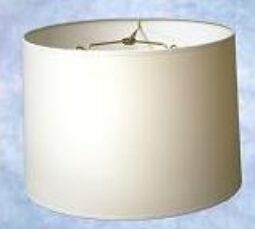
Drum shades are typically about one inch smaller in diameter at the top than the bottom. There are several types of drum shades, including retro drums, regular drums, shallow drums, deep drums, and extra-deep drums, often referred to as cylinders
Oval Shades

Oval lampshades are available in a variety of proportions – shorter and longer, and with a range of top to bottom dimensions.
Square Shades
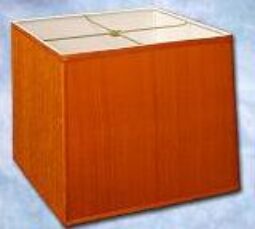
Empire lampshades slope gradually from the top to the bottom.
Rectangle Shade
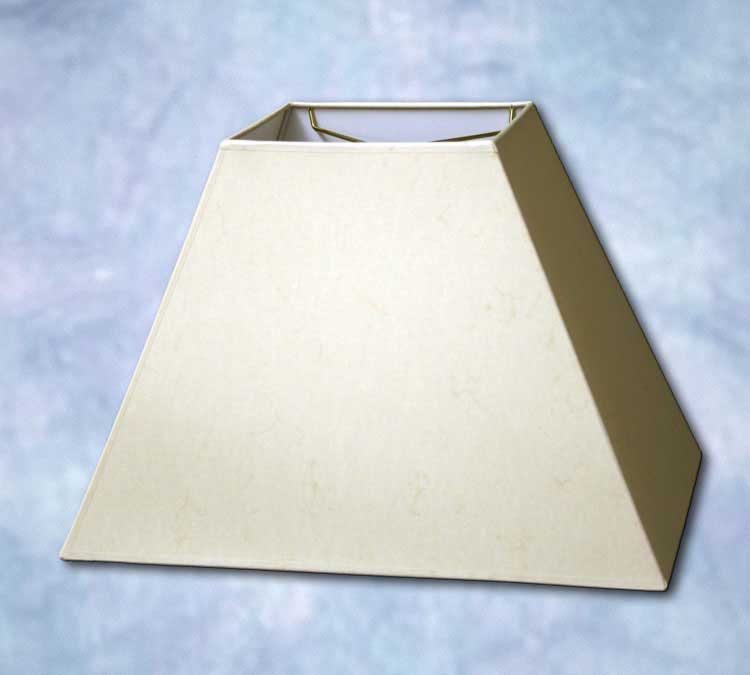
Empire lampshades slope gradually from the top to the bottom.
Hexagonal Shades

Empire lampshades slope gradually from the top to the bottom.
Pyramid Shades
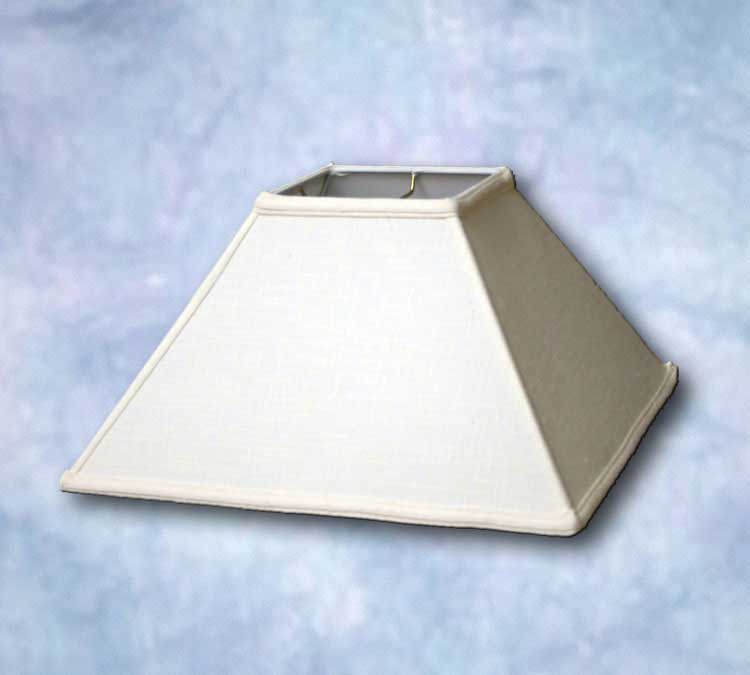
Empire lampshades slope gradually from the top to the bottom.
Silk Lampshades
Silk lampshade styles include everything available as a hardback – as well as numerous variations on the same themes. Any silk shade – round, oval, square, rectangular, hexagonal or octagonal – can have curves, bells, scallops, v-notches and gallery bottoms – either individually, or in combination.
Round Silk Shades
All silk shades are available in a variety of round shapes, including popular empires, coolies and drums. There are a number of variations on those “round” themes, and the following represent a more traditional variation and a more contemporary or modern variation:
Square Silk Shades
Because a silk lampshade is built on a frame, the possibilities for shapes and styles are endless. Square silk lampshades can have straight lines, as found in a drum-square lampshades or an empire square shade, or they may have a curve, as in a square bell, or with scallops or cut corners or inverted corners. Square lampshades are used on lamps that offer some form of a square element – either the body of the lamp, or the base of the lamp.
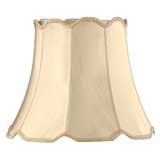
The Silk Empire Cylinder with a V-Notch is an example of a more traditional variation on the “round” theme
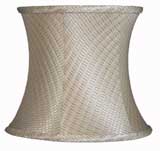
A Corset drum lampshade is an example of a more “whimsical” variation on the round lampshade theme:
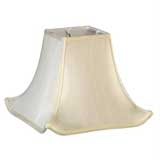
The Square Pagoda lampshade has a long and storied history as a decorative lampshade, for use on oriental lamps as well as lamps of other styles:
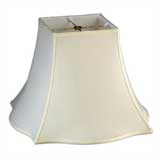
The Fancy Square lampshade has both a round element and a square element; for example an urn lamp on a square base.
Rectangle Silk Shades
Rectangle silk lampshades are available in a wide variety of styles – traditional to contemporary. Traditional rectangle styles include a cut corner rectangle bell, an empire rectangle or a pagoda. Contemporary rectangle styles include a rectangle drum or a straight corner rectangle pyramid.
Oval Silk Shades
Oval lampshades are a softer variation of the rectangle – longer than they are deep. Traditional oval lampshade styles include oval bells, inverted corner ovals, French ovals, and shallow oval bells. More contemporary oval lampshade styles include the oval drum, the oval cylinder, and the more “racy” racetrack oval! Oval lampshades – of various styles, work will with either an oval based lamp, or when you have a space constraint (bedside table against the wall), and need to minimize the depth of the lampshade.

The Cut Corner Rectangle Bell lampshade has “soft” corners and above average height – often considered a more traditional style lampshade:
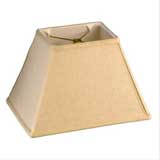
The Rectangle Pyramid is designed with sharp corners and a relatively small rectangular opening at the top of the lampshade; with clean, straight edges the pointed corners, the pyramid lampshade is often used on more contemporary styles.

The silk Bell Oval is an example of a traditional, oval lampshade:
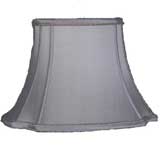
The Inverted Corner Oval silk lampshade is a great variation on a traditional oval style:
Hexagonal and Octagonal Silk Shades
Lampshade frames can also be designed with multiple, same-sized panels, as found in six-sided hexagonal lampshades and eight-sided octagonal lampshades. The “hex” and “octagon” shades can be short or tall, drum-like with nearly equal top and bottom diameters, or coolie like with much small top measurements as compared to the bottom shade diameter, built with straight lines or slightly curved or “belled” lines.
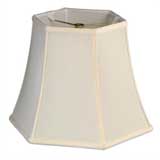
The Hexagonal Bell silk lampshade can be used successfully on a round lamp – particularly a round lamp with an hexagonal wood or metal base.
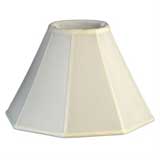
The Octagonal Coolie silk lampshade is a variation on the coolie style but with more definition:

Selecting a Replacement Lampshade
Ideally, when selecting a replacement lampshade, the lamp itself should be taken to a lampshade store with a trained professional to help you select the “extra-ordinary” shade for your lamps. The following are some things to think about in the selection of your replacement lampshade:
- What is the type of decor in the room in which the lamp resides?
- How is the lamp used in the room – for general lighting, for reading, for decoration?
- Is this an individual lamp, or one of a pair?
- What other lamps are in the room, and what types and colors of shades are on those lamps?
- What are the colors in the room?
In addition to the information gathered regarding the general location of the lamp, there are several other things to consider when selecting a replacement lampshade, such as:
- The shape of the lamp base; for example a round, curved base may suggest a round, slightly sloped or curved shade whereas a square or rectangular base may lead to consideration of a square or rectangular shade or a variation on that same theme;
- In general, the more elaborate the base, the more simple the lampshade;
- Consider the colors in the lamp base when selecting the color of the lampshade;
- The style of the lampshade should complement the lamp base, using “period” style lampshades, if appropriate.
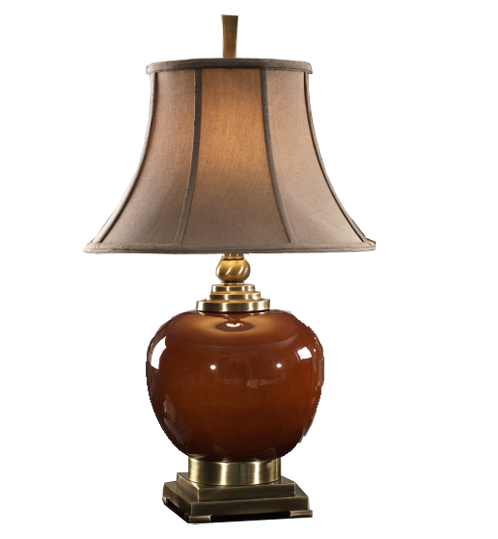
Fitting the Lampshade to the Lamp
A starting point for fitting a lampshade to a table lamp is to measure the height of the lamp from the table to just below the socket; the size of the shade you select will often be about the same. Of course, there are many exceptions – fat, but short lamps, for example, will require large shade to cover the circumference of the lamp; and tall skinny lamps will generally not need a shade as large as the lamp is tall – the proportions would not look right.
The lampshade should sit just above the top of the lamp, but below the “lampworks” – the hardware including the harp saddle and the socket. If the lamp has a neck, it is acceptable for the bottom of the shade to sit at any point along the neck. Unless the lampshade clips onto the bulb, the height of the lampshade can be changed by adjusting the height of the harp that holds the lampshade. Harps are the metal brackets that fit into a saddle located just under the socket. Harps come in heights ranging from 5 1/2″ to 13″. The taller the harp, the higher the lampshade will sit on the lamp, necessitating a longer length lampshade in order to avoid exposing the “lampworks”.

Light Bulbs & Lampshades
Most standard light sockets used in table and floor lamps can easily and safely accommodate incandescent light bulbs of up to 250 watts or more. The determining factor for the size, or wattage, of the incandescent light bulb you use in your lamp is generally not the socket, but instead the diameter at the top of the lampshade…the heat produced by the light bulb needs an escape route!
The maximum recommended watts / diameter of the lampshade are as follows:

